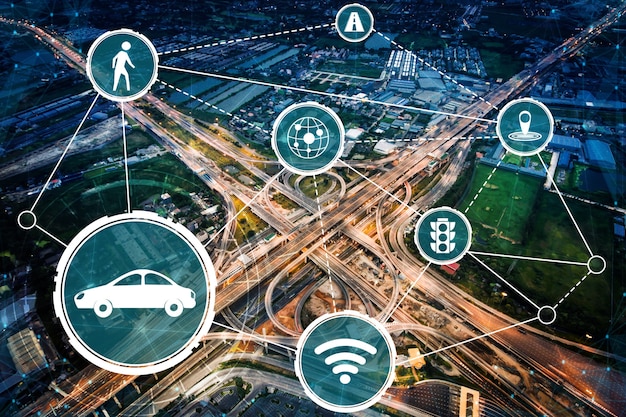Autonomous Vehicles on US Roads by 2030: Future of Transportation

The advent of autonomous vehicles is poised to fundamentally reshape the transportation landscape across US roads by 2030, promising advancements in safety, efficiency, and accessibility while presenting complex challenges related to regulation, infrastructure, and public acceptance.
The vision of self-driving cars navigating our streets once felt like science fiction, a distant dream confined to futuristic films. Yet, as we approach the mid-2020s, the concept of The Future of Transportation: Autonomous Vehicles on US Roads by 2030 is not merely a possibility but a burgeoning reality. This shift promises to transform how we commute, deliver goods, and interact with our urban and suburban environments, signaling a profound evolution in mobility.
The Current State of Autonomous Vehicle Technology
Autonomous vehicle (AV) technology has progressed remarkably, moving from controlled test environments to real-world applications. What began with basic driver-assist features has evolved into sophisticated systems capable of navigating complex traffic scenarios. Today, various levels of autonomy exist, defined by the Society of Automotive Engineers (SAE), ranging from Level 0 (no automation) to Level 5 (full automation). Most vehicles on the road today offer Level 1 or 2 features, such as adaptive cruise control or lane-keeping assist, providing a glimpse into the capabilities of advanced systems.
The journey towards full autonomy is predicated on several key technological pillars. High-definition mapping, crucial for accurate localization and path planning, has seen significant advancements. Equally important are sophisticated sensor suites, comprising LiDAR, radar, cameras, and ultrasonic sensors, which work in tandem to create a comprehensive, real-time understanding of the vehicle’s surroundings. These sensors feed vast amounts of data into on-board computing systems, where powerful artificial intelligence algorithms process information, predict behaviors, and make instantaneous driving decisions. The integration of these elements allows AVs to perceive their environment, interpret traffic signals, identify obstacles, and navigate without human intervention.
Key Technologies Powering AVs
- Advanced Sensor Fusion: Combining data from multiple sensor types (cameras, radar, LiDAR) to provide a robust and redundant perception of the environment, crucial for navigating diverse conditions like heavy rain or fog.
- Artificial Intelligence and Machine Learning: Algorithms that enable vehicles to learn from driving data, predict pedestrian and other vehicle movements, and adapt to unforeseen circumstances, continuously improving their decision-making capabilities.
- High-Definition Mapping and Localization: Extremely precise geospatial maps that include lane markings, traffic signs, and road geometry, allowing AVs to pinpoint their exact location within centimeters, even without strong GPS signals.
Despite these strides, challenges remain, particularly concerning sensor performance in adverse weather conditions and the ethical implications of AI decision-making. However, continuous research and development are pushing these boundaries, with companies routinely testing and refining their autonomous systems on public roads in several US states, collecting invaluable data that fuels further progress. The pace of innovation suggests that increasingly capable AVs will become a common sight by 2030, gradually integrating into the national transit framework.
Regulatory Landscape and Policy Evolution Towards 2030
The path for autonomous vehicles onto US roads is heavily influenced by the intricate web of state and federal regulations. While the National Highway Traffic Safety Administration (NHTSA) issues guidelines and sets safety standards, individual states largely determine how AVs can be tested and deployed within their borders. This fragmented approach has led to a patchwork of differing laws, which can complicate nationwide deployment strategies for AV developers. Some states, like California and Arizona, have been at the forefront, establishing clear frameworks for testing and even commercial operation, attracting significant investment and innovation.
As 2030 approaches, there’s a growing recognition of the need for a more harmonized regulatory environment. Federal agencies are actively engaging with industry stakeholders, researchers, and state governments to develop comprehensive policies that balance innovation with safety. These policies aim to address critical areas such as cybersecurity, data privacy, and liability in the event of an accident involving an AV. The goal is to create a predictable and supportive regulatory landscape that fosters responsible deployment while ensuring public trust and safety. Legislation is also being considered to delineate responsibilities between human occupants and autonomous systems, laying the groundwork for how these vehicles will operate within the existing legal framework.
The evolution of policy is not just about rules, but also about public engagement and education. Governments are exploring ways to inform the public about AV capabilities, limitations, and safety benefits, helping to build confidence and overcome skepticism. Stakeholder collaborations, including those between automakers, tech companies, and urban planners, are vital for developing policies that reflect real-world operational challenges and opportunities. By 2030, a more cohesive national strategy is expected to be in place, providing clarity for manufacturers and ensuring safer, more efficient autonomous operations across states.
Key Regulatory Challenges and Approaches
- Standardization Across States: Lack of uniform state laws creates hurdles for developers; federal efforts are underway to encourage consistent regulations for testing and deployment.
- Cybersecurity and Data Privacy: Ensuring the security of vehicle systems from malicious attacks and protecting the vast amount of data collected by AVs are paramount; new legislation is addressing these concerns.
- Liability Frameworks: Determining who is at fault in an autonomous vehicle accident (manufacturer, software developer, or vehicle owner) is complex and requires new legal paradigms.
- Public Acceptance and Education: Overcoming public skepticism and ensuring widespread understanding of AV technologies is a key policy objective to foster adoption.
The regulatory journey is dynamic, adapting to technological advancements and societal needs. By 2030, we anticipate a more mature and integrated regulatory system that supports the widespread adoption of AVs, paving the way for a more automated and connected transportation future.
Infrastructure Adaptation for an Autonomous Future
The widespread adoption of autonomous vehicles by 2030 will necessitate significant adaptations to existing transportation infrastructure. Roads designed primarily for human drivers may not be optimal for AVs, which rely on precise markings, clear signage, and robust communication networks. Initial steps include improving lane markings, ensuring the visibility and placement of traffic signs, and upgrading traffic light systems to be digitally recognizable by autonomous systems. Think of smart intersections that communicate directly with approaching AVs, optimizing traffic flow and reducing congestion.

Beyond visual cues, the future of infrastructure for AVs involves sophisticated communication technologies. Vehicle-to-everything (V2X) communication, encompassing vehicle-to-vehicle (V2V), vehicle-to-infrastructure (V2I), and vehicle-to-network (V2N) interactions, will be critical. This allows cars to “talk” to each other, to traffic signals, and to broader city networks, sharing real-time information about road conditions, hazards, and traffic patterns. Such communication enhances safety, enables platooning (where vehicles travel in close proximity to save fuel), and facilitates more efficient traffic management. The deployment of 5G networks will be pivotal in supporting the massive data exchange required for V2X systems, providing the low latency and high bandwidth necessary for instantaneous communication.
Urban planning will also evolve to accommodate AVs. Dedicated lanes for autonomous shuttles, smart parking solutions that guide AVs to available spaces, and strategically placed charging stations for electric AVs are all part of this transformation. Cities might redesign their layouts to optimize for autonomous traffic flow, potentially reducing the need for extensive parking facilities and freeing up urban space for other uses. The investment required for these infrastructure upgrades is substantial, but the long-term benefits in terms of reduced congestion, improved safety, and environmental impact could be immense. Public-private partnerships will likely play a crucial role in funding and implementing these changes, ensuring that urban environments are future-ready for autonomous fleets.
Economic and Societal Impact of Autonomous Vehicles
The integration of autonomous vehicles into daily life by 2030 is projected to unleash a cascade of economic and societal transformations across the United States. Economically, industries ranging from logistics and ride-sharing to insurance and automotive manufacturing stand on the precipice of significant disruption and innovation. The trucking industry, for instance, could see substantial shifts with autonomous long-haul vehicles reducing labor costs and potentially increasing efficiency. Ride-sharing services, powered by fully autonomous fleets, might offer more affordable and accessible transportation options, leading to a decline in individual car ownership in urban centers.
The potential for increased safety is one of the most compelling societal benefits. Human error accounts for over 90% of all traffic accidents. By removing the fallibility of human drivers, AVs hold the promise of drastically reducing collisions, injuries, and fatalities on US roads, saving billions in healthcare and property damage costs. This improved safety would also alleviate the emotional and financial burden associated with car accidents. Furthermore, the efficiency gains from optimized routes and reduced congestion could translate into significant time savings for commuters and businesses, boosting overall productivity.
Broader Societal Implications
- Enhanced Mobility for All: Autonomous vehicles can offer greater independence for the elderly, individuals with disabilities, and those unable to drive, expanding access to jobs, healthcare, and social activities.
- Urban Planning Reshaped: Reduced need for parking could free up valuable urban land for housing, parks, or commercial developments, transforming cityscapes.
- New Job Creation and Skill Shifts: While some driving jobs may diminish, new roles in AV development, maintenance, data management, and related service industries are expected to emerge, necessitating a re-skilling of the workforce.
- Environmental Benefits: Optimized routing, smoother driving, and the potential dominance of electric AVs could lead to reduced fuel consumption and lower carbon emissions.
However, these profound changes also come with complex challenges. Job displacement in the transportation sector is a significant concern, requiring proactive policies for workforce retraining and transition. Ethical dilemmas surrounding AI decision-making in unavoidable accident scenarios will continue to be debated, as will privacy concerns related to the vast amounts of data collected by AVs. Successfully navigating these transitions will require thoughtful policy, adaptive infrastructure, and robust public dialogue, ensuring that the benefits of autonomous transportation are equitably distributed across society by 2030.
Overcoming Challenges: Public Perception and Cybersecurity
The path to widespread autonomous vehicle adoption by 2030 is not solely paved with technological advancements and regulatory frameworks; it also crucially depends on overcoming significant challenges related to public perception and cybersecurity. Public trust in AV technology has been shaky, often influenced by high-profile accidents or sensationalized news reports. Surveys frequently reveal a considerable portion of the population expressing apprehension about riding in or sharing roads with self-driving cars. This skepticism stems from concerns about safety, reliability, and the perceived loss of human control.
Building public confidence requires sustained, transparent communication from manufacturers, researchers, and government agencies. This includes clearly articulating the rigorous testing protocols, demonstrating the safety benefits through data-driven evidence, and educating the public about the capabilities and limitations of existing AV systems. Pilot programs in various cities, allowing individuals to experience AVs firsthand in controlled environments, can also help demystify the technology and build familiarity. It’s not just about proving the technology works, but about demonstrating its reliability and safety in diverse real-world conditions to a sometimes-skeptical public.
Alongside public perception, cybersecurity presents a formidable and ongoing challenge. Autonomous vehicles are essentially computers on wheels, replete with sensors, software, and connectivity features that make them vulnerable targets for cyberattacks. A security breach could range from privacy violations (e.g., unauthorized access to personal data collected by the vehicle) to catastrophic safety risks (e.g., remote manipulation of steering, braking, or acceleration). The consequences of such attacks could be severe, impacting not only individual vehicles but potentially entire fleets or even traffic systems.
The industry and government are investing heavily in robust cybersecurity measures, including encryption, secure software updates, intrusion detection systems, and regular vulnerability testing. Establishing common cybersecurity standards and encouraging industry-wide collaboration on threat intelligence sharing are critical steps. As AVs become more connected and integrated into smart city infrastructures, the attack surface expands, demanding a proactive and adaptive approach to security. Ensuring a secure and trustworthy autonomous ecosystem by 2030 is paramount, fostering both public confidence and operational integrity.
Ethical Considerations and Societal Adaptation
As autonomous vehicles become more prevalent, the ethical landscape of transportation shifts dramatically. One of the most frequently debated ethical dilemmas revolves around unavoidable accident scenarios: in a situation where a collision is inevitable, how should an autonomous vehicle decide between two harmful outcomes? Should it prioritize the lives of its occupants, or minimize harm to pedestrians and other road users? These “trolley problem” scenarios, while rare in reality, highlight the complex moral programming decisions that developers must grapple with, often without clear societal consensus.
Beyond immediate accident ethics, the broader societal adaptation to AVs raises several profound questions. What happens to the millions of jobs currently held by professional drivers, from truck drivers to taxi operators? While new jobs in AV development, maintenance, and data management will emerge, the transition will require significant retraining and support programs to mitigate widespread unemployment. Furthermore, the role of human responsibility and accountability in a largely autonomous system needs to be clearly defined. If a fully self-driving car causes an accident due to a software glitch, who is liable—the passenger, the manufacturer, or the software provider?
The concept of “fairness” in AV deployment is also crucial. Will autonomous mobility be equally accessible and affordable to all segments of society, or will it exacerbate existing inequalities? Ensuring that the benefits of reduced congestion, improved safety, and enhanced mobility extend beyond affluent urban areas to rural and underserved communities will be a significant challenge. Considerations around data privacy, especially with vehicles collecting vast amounts of information about their surroundings and occupants, also remain a key ethical concern. Balancing innovation with responsible data stewardship is essential.
Ultimately, the successful integration of autonomous vehicles by 2030 depends not just on technological prowess, but on a collective societal dialogue. This includes robust regulatory frameworks that address these ethical quandaries, educational initiatives to prepare the workforce for new roles, and public policies that ensure equitable access and protect individual rights. Navigating these ethical waters thoughtfully and proactively will be vital in shaping a future where autonomous transportation serves the greater good, enhancing safety and quality of life for everyone.
The Road Ahead: Milestones and Predictions for 2030
Looking towards 2030, the trajectory for autonomous vehicles on US roads appears clearer, marked by several anticipated milestones and predictions shaping the future of transportation. While full Level 5 autonomy in all conditions might still be a distant horizon for widespread consumer ownership, the next five years will see a significant expansion of Level 4 autonomous operations in designated areas. This means self-driving taxis, shuttles, and delivery vehicles operating within geofenced zones in major cities, offering reliable and potentially more affordable services.
One key prediction is the proliferation of autonomous trucking and logistics. Long-haul routes on well-mapped interstate highways present a less complex environment than urban streets, making them ideal candidates for early and rapid AV adoption. This vertical could see substantial investment and deployment, leading to efficiencies in supply chains across the country. Additionally, last-mile autonomous delivery robots and smaller autonomous vehicles for specialized tasks (e.g., campus shuttles, airport transfers) will become increasingly common, reshaping urban delivery and transportation paradigms.
Anticipated Milestones by 2030
- Dominance of Level 4 Services: Expansion of geofenced autonomous ride-hailing and delivery services in numerous US cities, becoming a common urban transport option.
- Autonomous Trucking Scale-Up: Significant deployment of Level 4 autonomous trucks on highways, particularly for long-haul routes, optimizing logistics and reducing costs.
- Enhanced V2X Communication: Wider adoption of vehicle-to-everything (V2X) communication infrastructure, enabling smarter traffic management and improving vehicle safety.
- Refined Regulatory Frameworks: More harmonized state and federal regulations, providing clearer guidelines for AV testing, deployment, and operational safety.
- Public Acceptance Growth: Increased public trust and comfort with autonomous technology, driven by consistent safe operation and effective public education campaigns.
- AI and Sensor System Maturity: Continued advancements in AI and sensor technology, making AVs even more robust in adverse weather and complex scenarios.
The drive towards an all-electric and autonomous fleet will also gain momentum, motivated by environmental concerns and operational efficiencies. By 2030, many of the autonomous vehicles on US roads are expected to be electric, contributing to lower emissions and quieter cities. The integration of charging infrastructure with autonomous routing will be seamless, allowing vehicles to self-manage their power needs. The transition will not be without its challenges—from cybersecurity threats to public apprehension—but the collaborative efforts of government, industry, and academia are geared towards overcoming these hurdles. The journey towards 2030 promises a future where transportation is safer, smarter, and profoundly more efficient, fundamentally changing our relationship with mobility.
| Key Aspect | Brief Description |
|---|---|
| 🚀 Tech Progress | Significant advancements in AI, sensors (LiDAR, radar), and mapping, enabling robust Level 2-4 autonomy. |
| 🚦 Regulations | Evolving federal and state laws aim for harmonization, focusing on safety, liability, and data privacy for widespread adoption. |
| 🏗️ Infrastructure | Smart roads, V2X communication, and 5G networks are crucial for supporting AV operations and traffic efficiency. |
| ⚖️ Societal Impact | Projected decreases in accidents, increased mobility, and economic shifts (e.g., job displacement, new industries). |
Frequently Asked Questions about Autonomous Vehicles by 2030
▼
By 2030, we can expect to see widespread adoption of Level 2+ (advanced driver assistance) and increasing presence of Level 4 autonomous vehicles, particularly within geofenced areas. While Level 5 (full automation in all conditions) may still be developing, ride-hailing and delivery services with limited drivers will become common in specified urban zones.
▼
Infrastructure will adapt through improved lane markings, digitally readable signage, and the widespread implementation of Vehicle-to-Everything (V2X) communication. Smart intersections, interconnected traffic signals, and 5G networks will enable AVs to communicate with each other and the infrastructure, optimizing traffic flow and enhancing safety.
▼
Main safety concerns include sensor reliability in adverse weather, ethical decision-making in unavoidable accidents, and cybersecurity vulnerabilities. These are being addressed through advanced sensor fusion, AI ethics research for programming AV responses, and robust cybersecurity protocols, alongside extensive testing and regulatory oversight.
▼
The job market will see shifts. While driving-related jobs (e.g., trucking, taxi services) may decline, new roles in AV research, software development, AI, maintenance, sensor technology, and urban planning will emerge. This emphasizes the need for workforce retraining and adaptation programs to support the transition.
▼
Public perception is crucial. Widespread adoption hinges on building trust, which requires transparent communication about safety performance, rigorous testing, and education on AV capabilities. Positive real-world experiences from early deployments will be key to overcoming skepticism and encouraging broader acceptance among consumers and other road users.
Conclusion
The journey towards a future where autonomous vehicles are a common sight on US roads by 2030 is undoubtedly complex, yet increasingly tangible. From the rapid advancements in AI and sensor technology to the evolving regulatory frameworks and infrastructure adaptations, every element is aligning to reshape our transportation landscape. While significant challenges remain, particularly in building public trust and ensuring equitable access, the potential benefits—from dramatically improved safety and efficiency to enhanced mobility for all—are compelling. The collaborative efforts of policymakers, innovators, and the public will be instrumental in navigating this transformative period, leading to a transportation system that is safer, smarter, and more sustainable for generations to come.





